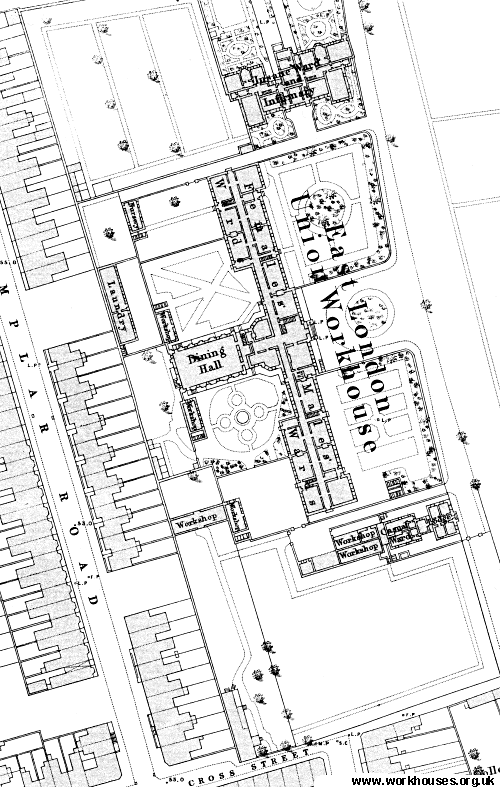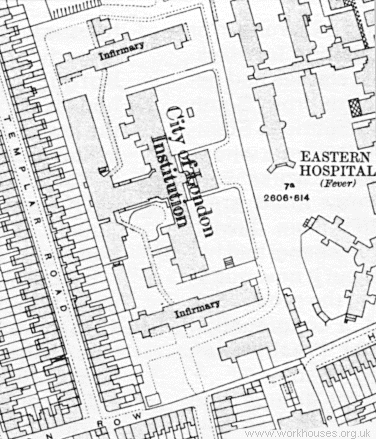East London
Up to 1834
The pre-1834 operation of the poor law and workhouses in the City of London is described in two separate pages on:
After 1834
The East London Poor Law Union formally came into existence on 12th December 1837. Its operation was overseen by an elected Board of Guardians, 20 in number, representing representing its 4 constituent parishes as follows (figures in brackets indicate numbers of Guardians if more than one): St Botolph, Aldersgate (2); St Botolph, Aldgate (5); St Botolph, Bishopsgate (6); St Giles, Cripplegate (7). The population falling within the new union at the 1831 census had been 31.311 — ranging from St Botolph, Aldersgate (population 5,306) to St Giles, Cripplegate (13,134). The average annual poor-rate expenditure for the period 1834-36 had been £19,233 or 12s.3d. per head of the population.
Initially, the East London Union made use of the existing workhouse buildings at 128 Aldersgate Street (parish of St Boltolph, Aldersgate) and at Dunning's Alley, Bishopsgate Street (parish of St Botolph, Bishopsgate). In 1849, the Aldgersgate Street workhouse could house 210 inmates and the Bishopsgate Street premises 396 inmates.
In November 1853, the foundation stone was laid for a new workhouse on a six-acre site to the south of Clifden Road at Homerton. The building could accommodate 836 inmates. A porter's lodge, with casual wards to its rear, lay at the south-east of the buildings. The main building had a T-shaped layout with its entrance at the eastern side. Administrative offices and the Master's quarters were placed at the centre of the block, male accommodation in the southern wing, and female in the north. A dining-hall with chapel above lay to the rear. An insane ward and infirmary were located in a separate block to the north of the workhouse. On the female side, a nursery and laundry block lay towards the western side of the site. The workhouse location and layout are shown on the 1870 map below.

East London workhouse site, 1870
With the opening of the Homerton workhouse, the Aldersgate Street and Bishopgate Street workhouses were closed. The Aldersgate Street building was badly damaged by fire in June 1855.
East London Union was wound up in 1869 with its constituent parishes being transferred to the City of London Union. The workhouse at Homerton continued in operation with new receiving wards being added in 1878.
In 1908, the City of London Union decided to concentrate their facilities at Homerton. The existing Homerton workhouse was substantially enlarged and extended with the addition of a new administrative block, nurses' home and 320-bed infirmary. Records from this date on tend to refer to the site as Lower Clapton rather than as Homerton.

Lower Clapton workhouse site, 1913
The site immediately to the east of the workhouse was acquired in 1868 by the Metropolitan Asyslums Board (MAB) for construction of their new Eastern Fever and Smallpox Hospital, also shown on the map above. In 1921, the workhouse site was sold to the MAB and incorporated in the hospital.
In 1930, the whole site was taken over by the London County Council and continued to operate as the Eastern (Fever) Hospitals, and then as the Eastern Hospital for general cases.
The Eastern Hospital closed in 1982 and most of the buildings demolished soon afterwards. In 1987, the new Homerton Hospital was erected on the site of the old workhouse.
Staff
- None.
Inmates
Records
Note: many repositories impose a closure period of up to 100 years for records identifying individuals. Before travelling a long distance, always check that the records you want to consult will be available.
The Ancestry UK- Ancestry: London Workhouse Admission/Discharges (1764-1930)
.
- London Poor Law and Board of Guardian Records (1738-1930)
.
- East London Union — Guardians' minute books (1837-1869) etc.
- Homerton workhouse — Admissions and discharges (1857-1902); Creed registers (1876-1911); Births (1865-1905); Deaths (1865-1908).
- Lower Clapton workhouse — Admissions and discharges (1911-22); Creed registers (1914-33); Births (1914-25); Deaths (1914-5).
Bibliography
- Higginbotham, Peter Workhouses of London and the South East (2019)
Links
- None.
Unless otherwise indicated, this page () is copyright Peter Higginbotham. Contents may not be reproduced without permission.


